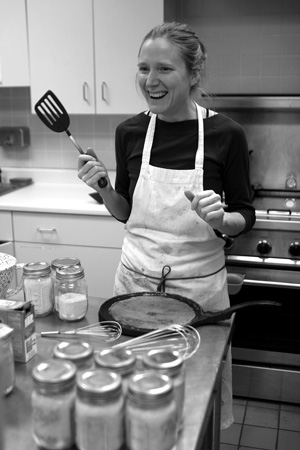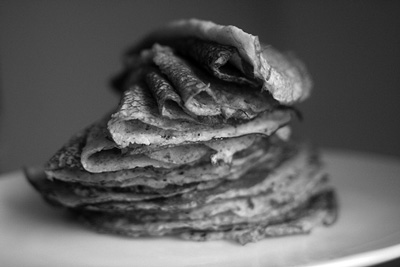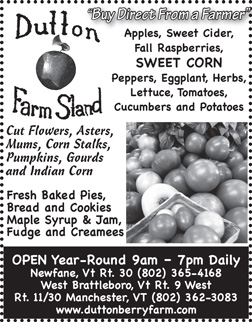News & Issues September 2015
Spreading the gospel of locally grown grains
The case for regional production start with taste, author says
 By TRACY FRISCH
By TRACY FRISCH
Contributing writer
TROY, N.Y.
Amy Halloran spent five years learning about the new movement to produce regional grains and flours, which she uses in pancakes and crepes. Ellie Markovitch photos
In Amy Halloran’s new book, flour is a character that can be wildly exciting, wood-fired ovens have lineages, and bread is “a bridge between nature and food, between the land and people.”
“The New Bread Basket,” published in late July by Chelsea Green, marks Halloran’s debut as a book author. It’s the culmination of her five-year quest to understand everything she could about locally produced flour and the movement to revive long-dormant skills and infrastructure for growing and processing wheat and other grains outside the Midwest.
“No one has explored this landscape with the depth and passion she brings to the subject,” wrote Samuel Fromartz, author of “In Search of the Perfect Loaf,” in a blurb extolling Halloran’s book.
Halloran has been baking all her life but didn’t become a connoisseur of wheat until the past few years. She brings a kitchen-table perspective to her study of regionally produced grains.
“I’m continually amazed by the flavors I can get from fresh flours, from this ingredient that’s so anonymous,” she said. “We think it’s just there to lend structure, because most of the flour that we eat is just the endosperm,” the starchy part of the grain seed.
“But the bran and germ are where the fat is and where the nutrition is,” she added.
Though her book chronicles the efforts of growers, plant breeders, millers, maltsters and other essential agents of change, Halloran does not consider herself to be a journalist. She prefers the terms writer and storyteller.
“I don’t want anyone to think I’m objective,” Halloran said. “I’m aligned with grain.”
She considers “The New Bread Basket” to be a “a social service” and “a tool that can build momentum for the movement.” By assembling stories of people who are working to revive the local production and processing of wheat and grains, she aims to inspire people to find new ways to bring regionally grown grain into their lives and communities.
A life-altering cookie
Halloran traces the idea for her book to the gift of a cookie five years ago. Her husband, the arborist Jack Magai, returned from a business trip tending the trees of wealthy clients in Connecticut and presented her with an oatmeal ganache bar from Wild Hive Bakery in Dutchess County.
Halloran recalls that she wasn’t very appreciative at first. But when she took a bite, she said, it was a revelation how “the oats and wheat stood so loud and flavorful against really good chocolate and butter.”
Despite her extensive experience as a baker, she had never before encountered such taste and strength in grain, and she was inspired to track down the source of the wonder.
“That cookie really changed my life,” she said.
The cookie was made from local wheat and oats from the Wild Hive Farm Community Grain Project, whose founder, Don Lewis, set up a small-batch milling operation about a decade ago in the hamlet of Clinton Corners, just off the Taconic Parkway.
To find out more about the push for locally produced grains, Halloran turned to the Northeast Organic Farming Association of New York. In January 2011, at the association’s annual conference in Saratoga Springs, she attended an all-day session on grains. There she met Glenda Neff, who, working under a farm-to-bakery grant, clued her into other events.
“That’s when I started getting first-hand tours from producers,” Halloran said.
The openness of some of the people she interviewed early on compelled her to delve more deeply. Thor Oechsner, a grain grower near Ithaca and the co-founder of Farmer Ground Flour, the brand of stone-ground flour Halloran swears by, became her first guide.
As Halloran began exploring the new grain movement, she was struck by the realization that farmers and other commercial enterprises producing or processing local grain for baking or brewing were not acting in isolation, but as partners in collaboration.
“I started to think of it as a great human muscle that was regenerating grain production,” she said. “That echoed the way that grains have always drawn us together and required cooperation.”
Research leads to book
For generations, grain harvest time made cooperation manifest; hence the images of parties of peasants cutting wheat with sickles and binding together sheaths of grain. But Halloran is actually referencing something more complex. She salutes farm advocates like June Russell of New York City’s Greenmarket and Elizabeth Dyck, an independent agronomist, who she said “are building the farming know-how and infrastructure we need for a regional food system” by “reaching backward and forward through time.”
At first, when Halloran traveled to visit farmers, millers, bakers and malt houses, she didn’t have an outlet for publishing her accounts and reflections. An invitation from Christina Davis, the founder of the From Scratch Club, to write a blog about grains on New York Capital Region group’s Web site gave her an initial audience and helped spur her on.
As part of her immersion in wheat, one year Halloran and her family tried growing it. Her two sons – Francis, now 17, and Felix, now 12 -- planted Warthog wheat with a grass seeder, and the family harvested about 30 pounds of wheat from one-tenth of an acre in the city of Troy.
Halloran’s neighbor, Howard Stoner, a retired math teacher raised on an Iowa farm, developed implements for small-scale grain processing and helped them at every stage. Halloran said she still grows some wheat “recreationally.”
Halloran’s self-funded, low-budget research has taken her from the Pacific Northwest to Maine, Vermont and elsewhere around the Northeast, as well as to Kansas. Everywhere she went, she brought back stories and became even more fascinated by the production of wheat and other grains.
“I’m so excited about what people are doing with grains,” she said. They’re my heroes.”
 A passion for pancakes
A passion for pancakes
One passion that predates and enhances her fascination with grains is Halloran’s love of pancakes (though not with syrup, she says). She has been cooking pancakes for her family and friends since she was a child, and she recalled how, in her 20s, she was served a blue cornmeal pancake at a restaurant and found the experience riveting.
“I went home and perfected it,” Halloran said.
Blue cornmeal pancakes were the first meal she made for her husband, and to this day Halloran said she makes pancakes every morning and often constructs meals around crepes with fillings like beet and wheat berry salad or cucumber and yogurt with herring.
At Honest Weight Food Co-op in Albany, Halloran recently presented a workshop on making flat cakes with regional grains, taking participants from field to griddle. (The event included a book signing.) She also is offering this workshop through the Agricultural Stewardship Association, a farmland conservancy serving Washington and Rensselaer counties, at The Arts Center of the Capital Region in Troy and, as part of her book promotion, at cooking stores and other venues.
The Honest Weight class, which was capped at 15 participants, brought together a chef and an assortment of home bakers and the curious, as well as one of Halloran’s sisters and a cousin. When one woman revealed that she couldn’t eat gluten, Halloran recommended a mixture of corn and buckwheat instead.
Doing these workshops and demonstrations is “super fun,” she says, because “I get to talk about why I love flour while I’m making crepes.”
While turning out batch after batch first of spelt pancakes followed by a series of large round rye crepes, she offered personal pointers on the art of making flat cakes – pancakes, crepes, and some ethnic variations on these – while at the same time giving her audience a larger context for the endeavor. She also answered a volley of questions without burning a single flat cake.
She offered historical details about wheat and baking technologies and clarified some confusing terminology, such as why people describe wheat as soft or hard (a function of the percentage of protein and level of gluten, with soft for pastry and hard for bread), as red or white (this refers to the color of bran), and as winter or spring (this refers to when the grain is planted; the harvest takes place regardless in the height of summer).
The audience ate appreciatively. On this occasion, Halloran skipped add-ons like berries or nuts so the eaters could fully experience the nuttiness of the grain and other distinctive flavors. But once everyone had tasted a plain crepe, she slathered each subsequent one with a generous dollop of Butterworks Farm’s organic whole milk Jersey yogurt, rolled it up and sliced it into servings.
Milling and grinding
When it comes to pancakes, Halloran is a purist. She objects to adding fat to pancake or crepe batter. For the stovetop baking, only butter will do, and she considers a cast aluminum griddle indispensible for its ability to evenly distribute heat. She brandished a rectangular griddle for the pancakes and a round one with a handle for crepe making.
Her basic pancake mix consists of fresh stone ground whole grain flour plus baking soda, double-acting aluminum-free baking powder, and salt. To create a batter, she adds milk and eggs. If she adds something like berries to the pancakes, she does it while they’re on the griddle.
Halloran buys hefty bags of Farmer Ground Flour, which is certified organic and stone milled near Ithaca. With an inventory of about 100 pounds of different flours typically on hand in her home, she tries to go through each sack of flour within three months.
Mass-produced flour, she explained, is just about always made in huge roller mills. They’re faster and more efficient than stone mills, which process only a tiny percentage of the wheat we consume.
Roller milling was invented in Europe in the mid 19th century, but it took several decades for these huge and elaborate milling factories to come to the United States. Halloran likens the milling apparatus of roller mills to a series of washing machine wringers. The mills break grains into their component parts and then send these through tubes to different bins. The miller then gets to determine how much of these different components to incorporate into the final product.
The term “whole wheat,” she explained, is a misnomer in roller-milled flour, because the germ, which is fragile and tends to go rancid after milling, is normally left out to extend shelf life. And only some of the bran, the fibrous protective coating around the wheat kernel, is put back. That’s because bran acts like little knives on the gluten-forming matrix that forms when flour is moistened, thereby interfering with dough’s ability to rise.
Halloran points out that crushing bran finely in a stone mill can solve this problem. And stone-ground flour is tastier because the germ is ground along with the rest of the grain kernel, she said.
Regarding heritage grain varieties -- those developed and grown before 1950 -- Halloran is pragmatic. She said a variety has got to be good for farmers to grow, meaning suitable to the climate. Here is the wet Northeast, farmers have to contend with fusarium, a fungal disease that can quickly render wheat unfit for human consumption.
Halloran’s interest in where food comes from and how it is produced began to take shape in 2001 when she was hired as the first manager of the Troy Waterfront Farmers Market. Over the next three years, she started the process of transforming the fledgling market into a beloved Troy institution. Drawing on her many community connections from growing up on the outskirts of Troy, in the rural hamlet of Melrose, she used her infectious enthusiasm to expand the audience for the market.
Often the people she reached had “no native interest in local food,” so Halloran said she would try to “leverage their interest.”
“I hope the book will be able to leverage change in the same way,” she added.
Although this is her first published book, Halloran has written plays, comic books, novels, short stories and essays. She freelanced for magazines and newspapers for many years and used to write regularly for the Albany-area alternative weekly Metroland. She teaches writing in community settings, most regularly offering writing workshops funded by the New York state Council on the Arts.
Today, as has been the case for years, Halloran pieces her share of the family livelihood together with a part-time job and a changing collection of writing projects and teaching gigs. She currently cooks community meals for up to a couple hundred people a day at the nonprofit agency Unity House.
She also teaches a capstone course on food justice for juniors and seniors at Russell Sage College in Troy. For the service-learning component, she takes her students into the kitchen at Unity House.

